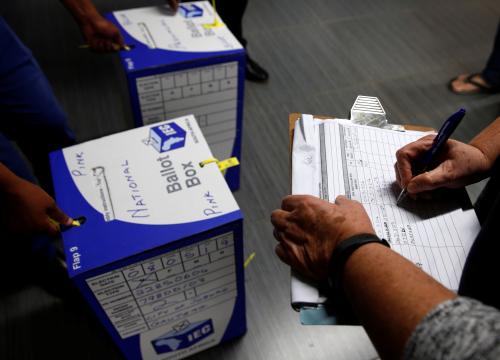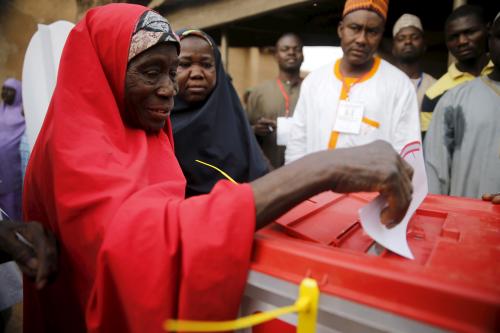Editor’s Note: This commentary is the third in a series on the Iranian elections and their aftermath. Writing from Tehran, Middle East expert Djavad Salehi-Isfahani analyzes the mood on the ground and comments on the prospects for future reform to heal Iran’s economic divisions.
A friend in Tehran has stopped going to work this week because of the crisis in the streets. He is staying at home not to protest the killing of demonstrators but to make sure his youngsters do not join them. He is part of 1.3 million families throughout Iran who are biting their nails waiting for this week’s national entrance exams to universities, the concour, to be over. (Many more have children taking exams in grade schools and universities.) These families had planned for a quiet week of no TV or socializing to keep their young contestants undisturbed.
Iran’s entire education system is centered around the concour. It is the reason why students work hard in school as well as the source of disappointment for the vast majority who fail to get into a good public university. About 80 percent of Iranians finish high school and take part in the “Big Test,” but few of whom are rewarded later with a good job and the chance to set up a family.
Nearly a quarter of people in their 20s are unemployed and half live with their parents. One would think that the strong restrictions against pre-marital relations would make them want to marry earlier, but lack of employment has forced the marriage age above that in other countries.
The sudden surge of support for Mr. Moussavi, the reformist candidate who has come to lead the protest movement, owes a lot to the desperate search of Iran’s youth for meaning in their lives. This new generation is highly educated and has ambitions for a middle class life that neither the economic nor the social system is able to fulfill.
This election was seen by youth and their families as a chance for change within the rules of the Islamic Republic. Despite the vetting of candidates by the Guardian Council, recent presidential elections have offered real choices, so voters’ optimism reflected by high turnout was not entirely misplaced.
However, this election brought a more polarized electorate to the polls than any in the past. On one side is the middle class, which has doubled in size since the reformist victory in the 1997 election of President Mohammad Khatami. Rapidly expanding health and educational opportunities since the revolution have transformed the Iranian family from traditional to modern, turning women from mothers and housewives into spouses, the Persian word for which — hamsar — literally means equal.
With the decline of patriarchy at home, demands for equal rights for women in society and greater social freedoms in general have grown. This is why Mr. Moussavi’s call to remove the morality police from the streets resonated so strongly with youth and the larger middle class even though he had little to say about jobs, housing and youth problems. The more productive members of this class also saw a Moussavi government as good for the economy because he promised to promote the rule of law and greater equality of opportunity for private business, which is now in unequal competition with the large public and semi-public sector.
On the other side is the country’s poor whose numbers have been shrinking, but whose demands for more economic justice have been increasing, thanks in no small part to the oil boom of the last few years. Post-revolution Iranian politics have been characterized much more by demands for redistribution than for more effective government and rule of law. The election of Mahmoud Ahmadinejad in 2005 tightened the populist grip just as the oil boom was reaching full force and demands for redistribution were growing. As it did in the 1970s, this oil boom increased inequality because it trickled from government coffers down an unequal power structure.
This trickling has further polarized society because of its strong urban bias. All money is first spent in Tehran and larger cities before reaching small towns and rural areas. Mr. Ahmadinejad promised to change this system, and tried to deliver on this promise through trips to provincial areas and handing out benefits. These populist policies came under attack from his opponents for having hurt economic growth, but may have convinced many among the poor and others in small towns and rural areas that he was at least trying.
Even in a country with a well functioning political system, the democratic process would fall short in reconciling such divergent demands. Iran’s deteriorating political atmosphere leaves little chance of going back to the business of daily life any time soon. A sizable minority — if not a majority — believes that the election was rigged, but has been banned from voicing its outrage. In the short run, given its overwhelming force, the government is likely to succeed in winning the street battle.
But its problems are much deeper than calming the streets. It must go beyond redistribution in order to grow the economy and create jobs. For this it needs the confidence of young people and the larger middle class, who are essential for building Iran’s future, but who feel snubbed by the stern sermon that Ayatollah Khamenei delivered last Friday and by the heavy hand of the security forces in restoring order. This week’s events are anything but encouraging.


Commentary
Op-edIran’s Election: Economic Fears and Discontents
June 23, 2009